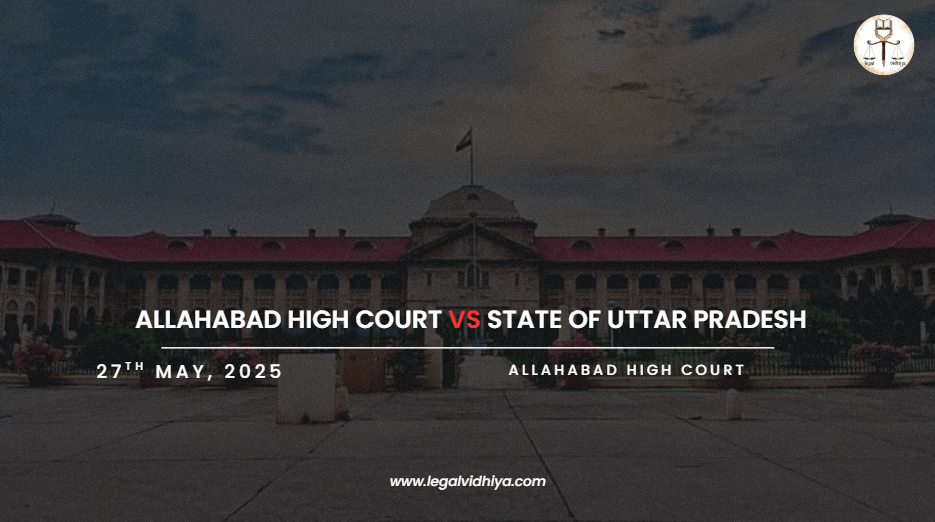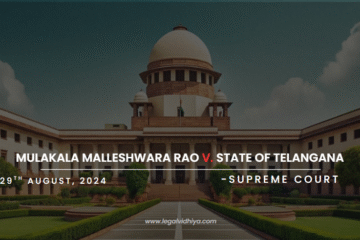
| CITATION | APPLICATION U/S 528 BNSS NO.- 10997OF 2025 |
| WRITE ONGOING | 27 MAY ,2025 |
| COURT NAME | ALLAHABAD HIGH COURT |
| PLAINTIFF/ PETITIONER | SHASHANK GUPTA ALIAS GUDDU AND 2 OTHERS |
| DEFENDANT/ RESPONDENT | STATE OF U.P AND ANOTHER |
| JUDGE | HON’BLE ARUN KUMAR SINGH DESHWAL |
- INTRODUCTION
Recent judgment by the Allahabad high court has now touched off the debate on whether it is the right thing to do – to apply or profane or not to apply at all the provisions of Section 528 of the Bharatiya Nagarik Suraksha Sanhita (BNSS) (Corresponding to Section 482 of CrPC) which came with effect from 2023. This section safeguards the constitutional authority of the High Court to issue orders in the interest of justice, prevent misuse of the legal process, and ensure that the provisions of the BNSS are upheld without obstruction. In the present matter High court was demanded to determine whether a FIR could be quashed during the investigation stage by using these inherent powers in the current case. Though ahead before Full Bench decision in Ramlal Yadav v. State of U.P that previously denied similar compass.
The bench analysed before clashing rulings by Supreme court of India, specifically
State of Haryana v. Bhajan Lal and Imran Pratapgadhi v. State of Gujarat, implicitly overruled Full Bench decision in Ramlal Yadav, the court took into consideration colliding precedent. The ruling is important because it provides judicial sense towards alignment in which individual liberty, procedural justice, constitutional protections have evolved.
- FACTS OF THE CASE
The case began with an application dispute an order dated 03.02.2025 issued by Chief judicial Magistrate, Chitrakoot, under section 175(3) of BNSS,which instructed police to file a FIR. subsequently, the petitioner amended the plea with the court’s approval to also ask for the quashing of the FIR dated 26.02.2025, registered as Case Crime No. 114 of 2025, involving offences under Sections 498A, 323, 504, 506, 342 IPC, read with Sections 3/4 of the Dowry Prohibition Act, at Karvi Police Station, Chitrakoot.
The Learned AGA challenged the application’s maintainability under Section 528 BNSS. He cited Ramlal Yadav v. State of U.P 1989, which established that Article 226 of the Constitution, not Section 482 CrPC (now Section 528 BNSS), should be used for similar applications. Still pleaders stated that the court had the right to use its inherent powers under the BNSS to quah the FIR as subsequent Supreme Court ruling had overruled Ramlal Yadav.
- ISSUES
- Can a high court intrude in the with a police investigation where no cognizable is disclosed in the FIR report?
- Whether a inherent power under section 528 BNSS(corresponding to 428 Crpc) can be exercised to quash the FIR during the stage of investigation?
- Can the Full Bench ruling in Ramlal Yadav v. State of U.P. be considered good law in light of other Supreme Court decisions such as Bhajan Lal, Pratapgadhi Imran, and Gulam Mustafa?
- JUDGEMENT
- This court disdainfully disagrees with the Full Bench judgement of this court in Ramlal Yadav wherein it is observed that FIR or consequential investigation cannot be quashed in exercise of essential power u/s 482 Cr.P.C. (corresponding Section 528 BNSS). Subsequent Supreme Court rulings affirm that FIRs can be quashed under Section 482 Cr.P.C. (Section 528 BNSS), if the conditions set forth in paragraph no.102 of Bhajan Lal as well as in paragraph no.33 of Neeharika Infrastructure are satisfied.
- This Court is of the opinion that, although the Full Bench decision in Ramlal Yadav has not been expressly reversed or overruled, the detailed discussion of circumstances and legal principle as articulated in the Apex Court’s judgement render the law established by Ramlal Yadav obsolete. As per the principle of “CESSANTE RATIONE CESSAT IPSA LEX” which was also considered by the Apex Court in the case of Devans Modern Breweries, the principle of stare decisis can be departed in such cases.
- This court hypercritically acknowledges that the legal principles established in the Full Bench decision of Ramlal Yadav may no longer be applicable due to recent developments in the law as interpreted by the Apex Court. In line with judicial discipline and the doctrine of stare decisis, as highlighted in Shanker Raju and Mishri Lal, the Court finds it appropriate to refer the matter to a nine-judge Larger Bench.. This referral is warranted since the judgment in Ramlal Yadav was delivered by a Bench of seven judges.
- We look forward to the perceptivity and guidance that the Larger Bench will give on the following questions-:
- In light of the law set forth by the Apex Court in the case of Bhajan Lal, Neeharika Infrastructure, and other subsequent judgments from the Hon’ble Apex Court, is the law laid down by the Full Bench in Ramlal Yadav that an FIR and the preceding investigation cannot be quashed by the High Court using its inherent powers under Section 482 of the Cr.P.C. (Section 528 of BNSS) still valid?
- (ii) Whether an FIR and the resulting investigation can be quashed under the inherent powers conferred by Section 528 of the BNSS (corresponding to Section 482 of the Cr.P.C.), if the criteria set forth in paragraph 102 of Bhajan Lal and paragraph 33 of Necharika Infrastructure are satisfied?
- The Registrar General is instructed to present the case record to the Hon’ble Chief Justice within three days for the conformation of a Larger Bench conforming of nine judges to address the substantiated issues.
- The interim order granted ahead will remain in effect until the investigation concludes in case crime no.114 of 2025, under Sections- 498A, 323, 504, 506, and 342 of the IPC, along with Sections 3 and 4 of the D.P. Act, at Police Station-Karvi, District-Chitrakoot
- REASONING
- The key issue before the high court was whether a person can approach the High Court under section 528 of the BNSS(equivalent to 428 of CrPC) to get an FIR quashed or if filing a writ petition under Article 226 of the constitution was the only method to get such relief. The State opposed the application based on the Full Bench decision in Ramlal Yadav v. State of U.P which stated that FIRs and investigations could not be quashed using inherent powers under section 428 CrPC. However that decision had made clear that such authority was only available when a charge sheet had been filed and the matter was brought before the court.
- Subsequently, the applicants made a great strong arguments that this approach is of out dated aided by amicus curiae and senior advocates. They stated that a number of Supreme Court decisions complying with Ramlal Yadav have unambiguously established that High Court have the inherent right to quash FIRs and investigations if it is found that the FIRs is malicious, frivolous, or amounts to abuse of process, or that it discloses no cognisable offence. Citations were submitted in cases such as State of Haryana v Bhajan Lal, Swapan Kumar Guha, Abhishek v. State of Madhya Pradesh, Imran Pratapgadhi v. State of Gujarat, and T.T. Antony v. State of Kerala, all of readily available the High Court’s power to intervene in even during the process of an investigation for the sake of justice.
- The court additionally examined towards the Ramlal Yadav ruling’s basis. The privy council’s verdict in Khawaja Nazir Ahmad (1944), which was interpreted to state that courts shouldn’t hamper police investigations, was turned out to possess endured an important means of assistance for the Full Bench. This interpretation, however, overlooked the fact that even the Privy Council granted taking part when no crime was proven. Moreover, the decision depended on section 491 of the 1898 CrPC, which gave the High court the power to use Habeas corpus to prevent unlawful investigation. However, the 1973 CrPC removed that clause, and it is no longer in effect. Hence, there would be no statutory remedy left for someone who is wrongfully accused, if Ramlal Yadav strictly followed there would be no recourse and would have to rely on section 528 BNSS.
- The court observed the doctrine of ‘stare decisis’, which implies that lower courts should follow the decisions of larger benches. Ramlal Yadav’s authority has diminished since it was founded ineffective and has been overturned by Supreme Court rulings. The court invoked the legal maxim ‘cessante ratione cessat ipsa lex’, which says that when the premise behind a law or a judgement is no longer valid, the law itself must be re- examined.
- However the Court practiced a cautious and respectful approach by referring the case to a Larger Bench of nine judges for formal reconsideration instead of directly overturning the Full Bench. This allows the correction of outdated interpretations while ensuring the preservation of the judicial discipline of respecting to precedent.
The court granted the applicants’ beforehand safeguard to remain in effect in the interim, permitting the investigation against them to continue while they are shielded from arrest or coercive action pending till further order.
- CONCLUSION
The court acknowledged in this pivotal moment that the established law prohibiting the revocation of FIRs under section 528 BNSS (formally section 428 CrPC) is outdated with changing legal norms. The court decided that inherent powers can be used to strop injustice, acknowledging various Supreme Court rulings which allows High Court the power to take action in even at the FIR stage. It referred the case to a larger nine judge bench for final clarity, making sure both judicial discipline and adaptive legal development, although it abstained from overturning the old Full Bench verdict.
- REFERENCES
- https://elegalix.allahabadhighcourt.in/elegalix/WebShowJudgment.do?judgmentID=12383915
- The Times of India.
- Live Law.
Written by Gopika Maheshwari; an intern under Legal Vidhiya.
Disclaimer: The materials provided herein are intended solely for informational purposes. Accessing or using the site or materials does not establish an attorney-client relationship. The information presented on this site is not to be construed as legal or professional advice, and it should not be relied upon for such purposes or used as a substitute for advice from a licensed attorney in your state. Additionally, the viewpoint presented by the author is personal.
‘Social Media Manager’ and ‘Case Analyst’ of Legal Vidhiya.




0 Comments